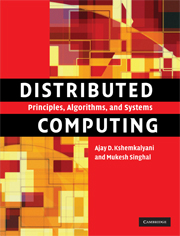Book contents
- Frontmatter
- Contents
- Preface
- 1 Introduction
- 2 A model of distributed computations
- 3 Logical time
- 4 Global state and snapshot recording algorithms
- 5 Terminology and basic algorithms
- 6 Message ordering and group communication
- 7 Termination detection
- 8 Reasoning with knowledge
- 9 Distributed mutual exclusion algorithms
- 10 Deadlock detection in distributed systems
- 11 Global predicate detection
- 12 Distributed shared memory
- 13 Checkpointing and rollback recovery
- 14 Consensus and agreement algorithms
- 15 Failure detectors
- 16 Authentication in distributed systems
- 17 Self-stabilization
- 18 Peer-to-peer computing and overlay graphs
- Index
18 - Peer-to-peer computing and overlay graphs
Published online by Cambridge University Press: 05 June 2012
- Frontmatter
- Contents
- Preface
- 1 Introduction
- 2 A model of distributed computations
- 3 Logical time
- 4 Global state and snapshot recording algorithms
- 5 Terminology and basic algorithms
- 6 Message ordering and group communication
- 7 Termination detection
- 8 Reasoning with knowledge
- 9 Distributed mutual exclusion algorithms
- 10 Deadlock detection in distributed systems
- 11 Global predicate detection
- 12 Distributed shared memory
- 13 Checkpointing and rollback recovery
- 14 Consensus and agreement algorithms
- 15 Failure detectors
- 16 Authentication in distributed systems
- 17 Self-stabilization
- 18 Peer-to-peer computing and overlay graphs
- Index
Summary
Introduction
Peer-to-peer (P2P) network systems use an application-level organization of the network overlay for flexibly sharing resources (e.g., files and multimedia documents) stored across network-wide computers. In contrast to the client–server model, any node in a P2P network can act as a server to others and, at the same time, act as a client. Communication and exchange of information is performed directly between the participating peers and the relationships between the nodes in the network are equal. Thus, P2P networks differ from other Internet applications in that they tend to share data from a large number of end users rather than from the more central machines and Web servers. Several well known P2P networks that allow P2P file-sharing include Napster, Gnutella, Freenet, Pastry, Chord, and CAN.
Traditional distributed systems used DNS (domain name service) to provide a lookup from host names (logical names) to IP addresses. Special DNS servers are required, and manual configuration of the routing information is necessary to allow requesting client nodes to navigate the DNS hierarchy. Further, DNS is confined to locating hosts or services (not data objects that have to be a priori associated with specific computers), and host names need to be structured as per administrative boundary regulations. P2P networks overcome these drawbacks, and, more importantly, allow the location of arbitrary data objects.
- Type
- Chapter
- Information
- Distributed ComputingPrinciples, Algorithms, and Systems, pp. 677 - 730Publisher: Cambridge University PressPrint publication year: 2008



